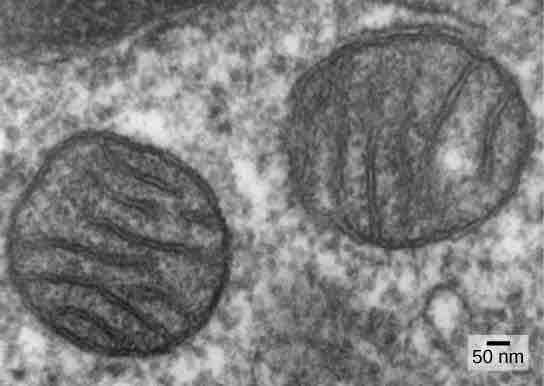Relationship between Endosymbiosis and Mitochondria
One of the major features distinguishing prokaryotes from eukaryotes is the presence of mitochondria. Eukaryotic cells contain anywhere from one to several thousand mitochondria, depending on the cell's level of energy consumption. Each mitochondrion measures between 1 to 10 µm in length and exists in the cell as an organelle that can be ovoid to worm-shaped to intricately branched. Mitochondria arise from the division of existing mitochondria. They may fuse together. They move around inside the cell by interactions with the cytoskeleton. However, mitochondria cannot survive outside the cell. As the amount of oxygen increased in the atmosphere billions of years ago and as successful aerobic prokaryotes evolved, evidence suggests that an ancestral cell with some membrane compartmentalization engulfed a free-living aerobic prokaryote, specifically an alpha-proteobacterium, thereby giving the host cell the ability to use oxygen to release energy stored in nutrients. Alpha-proteobacteria are a large group of bacteria that includes species symbiotic with plants, disease organisms that can infect humans via ticks, and many free-living species that use light for energy. Several lines of evidence support the derivation of mitochondria from this endosymbiotic event. Most mitochondria are shaped like alpha-proteobacteria and are surrounded by two membranes, which would result when one membrane-bound organism engulfs another into a vacuole. The mitochondrial inner membrane involves substantial infoldings called cristae that resemble the textured, outer surface of alpha-proteobacteria . The matrix and inner membrane are rich with enzymes necessary for aerobic respiration.

Micrograph of mammaliam mitochondria
In this transmission electron micrograph of mitochondria in a mammalian lung cell, the cristae, infoldings of the mitochondrial inner membrane, can be seen in cross-section.
Mitochondria divide independently by a process that resembles binary fission in prokaryotes. Specifically, mitochondria are not formed de novo by the eukaryotic cell; they reproduce within the cell and are distributed between two cells when cells divide. Therefore, although these organelles are highly integrated into the eukaryotic cell, they still reproduce as if they are independent organisms within the cell. However, their reproduction is synchronized with the activity and division of the cell. Mitochondria have their own circular DNA chromosome that is stabilized by attachments to the inner membrane and carries genes similar to genes expressed by alpha-proteobacteria. Mitochondria also have special ribosomes and transfer RNAs that resemble these components in prokaryotes. These features all support that mitochondria were once free-living prokaryotes.
Mitochondrial Genes
Mitochondria that carry out aerobic respiration have their own genomes, with genes similar to those in alpha-proteobacteria. However, many of the genes for respiratory proteins are located in the nucleus. When these genes are compared to those of other organisms, they appear to be of alpha-proteobacterial origin. Additionally, in some eukaryotic groups, such genes are found in the mitochondria, whereas in other groups, they are found in the nucleus. This has been interpreted as evidence that genes have been transferred from the endosymbiont chromosome to the host genome. This loss of genes by the endosymbiont is probably one explanation why mitochondria cannot live without a host.
Despite the transfer of genes between mitochondria and the nucleus, mitochondria retain much of their own independent genetic material. One possible explanation for mitochondria retaining control over some genes is that it may be difficult to transport hydrophobic proteins across the mitochondrial membrane as well as ensure that they are shipped to the correct location, which suggests that these proteins must be produced within the mitochondria. Another possible explanation is that there are differences in codon usage between the nucleus and mitochondria, making it difficult to be able to fully transfer the genes. A third possible explanation is that mitochondria need to produce their own genetic material so as to ensure metabolic control in eukaryotic cells, which indicates that mtDNA directly influences the respiratory chain and the reduction/oxidation processes of the mitochondria.